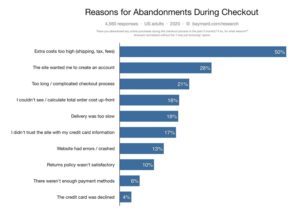There’s nothing as rewarding after a marketing campaign than seeing a full online shopping cart “move” through to a purchase. All too often, however, shoppers abandon their cart before completing a purchase. In fact, nearly 70 percent of shoppers leave goods in their carts, according to research from Baymard Institute. Having an effective abandoned cart email strategy can make all difference between money left on the table—or, rather, in the cart—and revenue.
An effective abandoned cart email strategy begins with using data to understand why website’s visitors left items in their cart at checkout and exited. Even if you don’t know the exact reason for each specific customer, you can use a combination of insights for why shoppers abandon their carts in general (see chart below) and behavior data specific to your customers and other site visitors to craft relevant messaging, reach out in the ideal time frame, and turn a lost sale into a purchase.
Connected data is essential for this. When you’re able to link disparate data from first-party, second-party, and third-party sources to create a holistic view of your customers, you can use that unique insight to transform common abandoned cart email strategies into data-driven ones that increase performance.

As with personalization in general, any personalization that you can apply to abandoned cart emails will help to improve their effectiveness. Abandoned cart emails that have a generic subject line, such as “Looks like you forgot something,” won’t be as effective as those that are directly relevant to each shopper. Let’s look at how connected data can help improve abandoned cart emails.
Abandoned Cart Email Strategy: Subject Lines
One of the most common reasons that shoppers abandon their cart is extra costs, such as shipping, taxes or other fees. If that’s a concern for your customers, consider using abandoned cart emails that highlight benefits that counter this issue. For example, citing top ratings or reviews that emphasize the value of your products. In this case, the subject line could say something like, “You’ve left a 5-start widget in your cart.” If a shopper abandoned several items, you could use past purchase data to select which product to highlight in the subject line.
If people leave multiple products, focus on the one that’s likely to be the most compelling to a specific customer so the subject line is especially relevant, and does not dilute the messaging.
Ratings and Reviews
When you have connected data, it’s easier to see which customers have similar attributes or preferences. You can use this insight for abandoned cart emails to include reviews from customers who share similar attributes to the shopper who has abandoned their cart.
Using this approach also can help build trust and credibility among newer customers. They’ll see that not only are your company’s products highly rated, but also that customers who are similar to them in some way have purchased and are enjoying those products.
Fear of Missing Out (aka FOMO)
Similarly, abandoned cart emails can create FOMO with “don’t be the one to miss out” type messaging. You can use connected data to see which customer types or segments exhibit similar behaviors and preferences and use that information. For example, “Don’t be the only one who’s bought product X not to complement it with product Y” or “Environmentalists swear by this widget. Don’t miss your opportunity to get one before they sell out.”
Then you can personalize a call-to-action by directing people back to a specific item in their cart based on that FOMO messaging.
Loyalty Over Discounts
In most cases, it’s unwise to offer discounts in abandoned cart emails. You’ll train customers to abandon their purchase to wait for the coupon you’re certain to send. Additionally, not only will you sacrifice margin, but you also might erode the trust of high-value customers who see that all it takes to get a discount is to abandon a cart.
Instead, use the data from a customer loyalty program in abandoned cart emails. For instance, you can use loyalty data to see how many points a customer has accrued to inform relevant messaging. If the data shows that they have X points accrued, messaging can remind them that they can use those points toward their purchase. If they don’t have points accrued, you can note how many points they’ll need before earning a reward. Even better, you can cite how many points their abandoned purchase would be worth if they complete it.
Abandoned Cart Email Strategy Best Practice: Timing and Frequency
When should you reach out and how many follow-up emails should be in the series? There are many “standard formulas” for calculating this. Instead, base an abandoned cart email strategy on overall past performance and data specific to your customers. One customer may respond to a first abandoned cart email sent within the hour, while another shopper might find that intrusive. Use connected data to move at the cadence of each customer.
You can also use connected customer data to see whether asking for a longer-term relationship is appropriate for a specific abandoned cart email series. For instance, if you have an email newsletter and know that a customer who has left items in a cart at checkout is not a subscriber, you can use an abandoned cart email series to encourage them to subscribe. This will help you stay top-of-mind for shoppers who do want to make the purchase but aren’t ready for some reason.
Stay Connected
It’s easy to set and forget a generic abandoned cart email series. Even nonspecific abandoned cart emails — “Looks like you forgot something” — will generate conversion. Using connected data to inform and support abandoned cart emails will allow for the type of personalization customers expect today. As a result, the customer experience improves, customer satisfaction rises, and the performance of abandoned cart emails increases.
Related Content
Dynamic Offer Management Can Be Customer-Centric: Here’s How
Augment Customer Segmentation with a Personalized CX
Be in-the-know with all the latest customer engagement, data management, and Redpoint Global news by following us on LinkedIn, Twitter, and Facebook.
